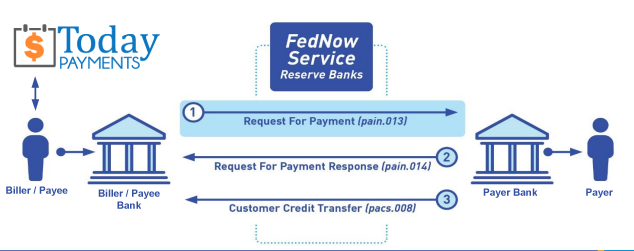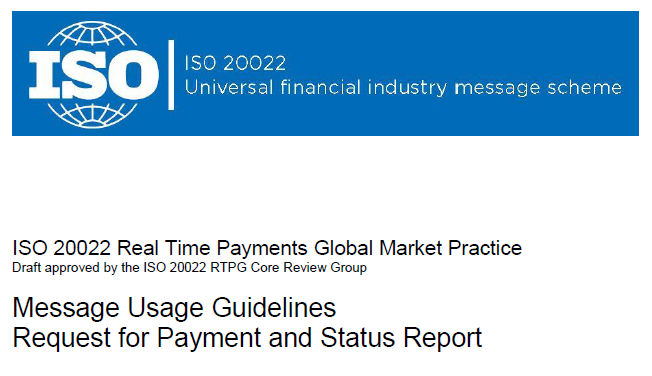Send Request for Payment
At TodayPayments.com, we empower merchants, enterprises, and payment platforms with the tools to generate and send Request for Payment (RfP) files through FedNow® and RTP® to any bank or credit union. Using modern formats like Excel, XML, JSON, and rich ISO 20022 messaging, we streamline batch invoicing, enable alias-based security, and deliver instant funding with reconciliation tools your CFO will love.
FedNow® and RTP® RfP File Invoicing for All Banks
The New Era of Instant Invoicing Is Here
In today's competitive, digital-first economy, waiting days for invoice payments is no longer acceptable. Businesses need real-time invoicing, real-time payments, and real-time certainty.
TodayPayments.com now makes it easy to send Request for Payment (RfP) files to any U.S. bank or credit union via FedNow® and RTP®. Whether you manage B2B or C2B transactions, you can now batch upload RfP files using Excel, XML, or JSON, and get paid instantly with certainty—no bank visit required.
One Platform. Nationwide Invoicing. Real-Time Payments.
TodayPayments.com enables merchants, billers, and platforms to upload and send Request for Payment (RfP) files across the FedNow® and Real-Time Payments (RTP®) networks—covering all U.S. banks and credit unions.
You can now:
- Upload batch invoice files from your accounting software
- Trigger one-time or recurring invoice requests
- Generate hosted payment links for customers
- Use mobile, SMS, or email invoicing to request good funds in real-time
All with rich ISO 20022-compliant data messaging and full compatibility across payment networks.
File Formats and Delivery Methods
Simplify Integration and Maximize Compatibility.
TodayPayments.com supports multiple file formats for sending RfPs:
- Excel (.xlsx) – Simple for billing teams and bookkeepers
- XML – Compliant with ISO 20022 standards
- JSON – Ideal for API integrations, SaaS, and app developers
- ISO 20022 – Embedded structured data, message-level validation
Invoices and RfPs can be sent via:
- Batch file uploads through the web portal
- API integrations with QuickBooks® or ERP systems
- Mobile-friendly links through text or email
- Hosted Payment Pages tied to each RfP message
You can tag each transaction with invoice numbers, payment descriptions, and custom metadata—plus, alias-based security allows use of email or cell phone in place of traditional banking info.
Top Benefits and Features
- Send and receive real-time credit transactions via FedNow® & RTP®
- Full B2B and C2B compatibility
- No credit checks and zero setup fees
- Batch uploads for one-time or recurring invoices
- API support for developers and tech-savvy users
- Alias-based invoicing using email addresses or mobile numbers
- Reconciliation reports built for bookkeepers, CFOs, and auditors
- Secure hosted payment links embedded in each RfP
- Multi-bank and multi-alias support (100+ identities per account)
- Designed for high-risk and bad credit merchants
- Accept ACH, card, RTP®, and FedNow® payments—all in one platform
To send FedNow and Real-Time Payments (RTP) Request for Payments (RfP) from the payee to multiple payers as a batch file, you need to create a batch file that adheres to the ISO 20022 format (or another format your payment processor or bank supports). Below is a guide to creating, structuring, and sending a batch Request for Payment file.
1. Batch File Structure Overview
In a batch Request for Payment, you include multiple transactions (or payment requests) in one file. The ISO 20022 message type used for batch processing is typically Pain.013 for Request for Payment (RfP).
For example, a batch file contains multiple payment instructions, each corresponding to a different payer. Each transaction includes:
- Payee details (your business).
- Payer details (customer or debtor).
- Transaction amount.
- Remittance information (e.g., invoice numbers).
2. Example of ISO 20022 Batch Request for Payment (Pain.013)
Here’s an example of how to structure a batch Pain.013 file in ISO 20022 format:
xml
<Document>
<CstmrCdtTrfInitn>
<GrpHdr>
<MsgId>BatchRequest001</MsgId>
<CreDtTm>2024-09-15T12:00:00</CreDtTm>
<NbOfTxs>3</NbOfTxs>
<CtrlSum>4500.00</CtrlSum> <!-- Total sum of all transactions -->
</GrpHdr>
<!-- First Payment Request -->
<PmtInf>
<PmtInfId>PmtInf001</PmtInfId>
<PmtMtd>TRF</PmtMtd>
<ReqdExctnDt>2024-09-15</ReqdExctnDt>
<Dbtr>
<Nm>Customer One</Nm>
<PstlAdr>
<Ctry>US</Ctry>
<AdrLine>123 Main St</AdrLine>
</PstlAdr>
</Dbtr>
<DbtrAcct>
<Id>
<IBAN>US1234567890</IBAN>
</Id>
</DbtrAcct>
<Cdtr>
<Nm>Your Business Name</Nm>
<PstlAdr>
<Ctry>US</Ctry>
<AdrLine>789 Business Ave</AdrLine>
</PstlAdr>
</Cdtr>
<CdtrAcct>
<Id>
<IBAN>US9876543210</IBAN>
</Id>
</CdtrAcct>
<Amt>
<InstdAmt Ccy="USD">1500.00</InstdAmt>
</Amt>
<RmtInf>
<Ustrd>Invoice #001</Ustrd>
</RmtInf>
</PmtInf>
<!-- Second Payment Request -->
<PmtInf>
<PmtInfId>PmtInf002</PmtInfId>
<PmtMtd>TRF</PmtMtd>
<ReqdExctnDt>2024-09-15</ReqdExctnDt>
<Dbtr>
<Nm>Customer Two</Nm>
<PstlAdr>
<Ctry>US</Ctry>
<AdrLine>456 Secondary St</AdrLine>
</PstlAdr>
</Dbtr>
<DbtrAcct>
<Id>
<IBAN>US2234567890</IBAN>
</Id>
</DbtrAcct>
<Cdtr>
<Nm>Your Business Name</Nm>
<PstlAdr>
<Ctry>US</Ctry>
<AdrLine>789 Business Ave</AdrLine>
</PstlAdr>
</Cdtr>
<CdtrAcct>
<Id>
<IBAN>US9876543210</IBAN>
</Id>
</CdtrAcct>
<Amt>
<InstdAmt Ccy="USD">2000.00</InstdAmt>
</Amt>
<RmtInf>
<Ustrd>Invoice #002</Ustrd>
</RmtInf>
</PmtInf>
<!-- Third Payment Request -->
<PmtInf>
<PmtInfId>PmtInf003</PmtInfId>
<PmtMtd>TRF</PmtMtd>
<ReqdExctnDt>2024-09-15</ReqdExctnDt>
<Dbtr>
<Nm>Customer Three</Nm>
<PstlAdr>
<Ctry>US</Ctry>
<AdrLine>789 Tertiary St</AdrLine>
</PstlAdr>
</Dbtr>
<DbtrAcct>
<Id>
<IBAN>US3234567890</IBAN>
</Id>
</DbtrAcct>
<Cdtr>
<Nm>Your Business Name</Nm>
<PstlAdr>
<Ctry>US</Ctry>
<AdrLine>789 Business Ave</AdrLine>
</PstlAdr>
</Cdtr>
<CdtrAcct>
<Id>
<IBAN>US9876543210</IBAN>
</Id>
</CdtrAcct>
<Amt>
<InstdAmt Ccy="USD">1000.00</InstdAmt>
</Amt>
<RmtInf>
<Ustrd>Invoice #003</Ustrd>
</RmtInf>
</PmtInf>
</CstmrCdtTrfInitn>
</Document>
Key Fields:
- GrpHdr (Group Header): Contains overall batch details like the total number of transactions (NbOfTxs) and total amount (CtrlSum).
- PmtInf (Payment Information):
Contains individual payment requests.
- Dbtr (Debtor): The payer (customer).
- Cdtr (Creditor): The payee (your business).
- Amt: The amount of the payment request.
- RmtInf (Remittance Information): Unstructured data such as invoice numbers.
3. Creating Batch Files in Other Formats
CSV Example:
csv
MsgId,DebtorName,DebtorIBAN,CreditorName,CreditorIBAN,Amount,Currency,InvoiceNumber
BatchRequest001,Customer One,US1234567890,Your Business Name,US9876543210,1500.00,USD,INV001
BatchRequest001,Customer Two,US2234567890,Your Business Name,US9876543210,2000.00,USD,INV002
BatchRequest001,Customer Three,US3234567890,Your Business Name,US9876543210,1000.00,USD,INV003
JSON Example:
json
{
"BatchRequest": {
"MsgId": "BatchRequest001",
"CreationDateTime": "2024-09-15T12:00:00",
"NumberOfTransactions": 3,
"Transactions": [
{
"PaymentInfoId": "PmtInf001",
"Debtor": {
"Name": "Customer One",
"IBAN": "US1234567890"
},
"Creditor": {
"Name": "Your Business Name",
"IBAN": "US9876543210"
},
"Amount": {
"Currency": "USD",
"Value": 1500.00
},
"RemittanceInformation": {
"Unstructured": "Invoice INV001"
}
},
{
"PaymentInfoId": "PmtInf002",
"Debtor": {
"Name": "Customer Two",
"IBAN": "US2234567890"
},
"Creditor": {
"Name": "Your Business Name",
"IBAN": "US9876543210"
},
"Amount": {
"Currency": "USD",
"Value": 2000.00
},
"RemittanceInformation": {
"Unstructured": "Invoice INV002"
}
},
{
"PaymentInfoId": "PmtInf003",
"Debtor": {
"Name": "Customer Three",
"IBAN": "US3234567890"
},
"Creditor": {
"Name": "Your Business Name",
"IBAN": "US9876543210"
},
"Amount": {
"Currency": "USD",
"Value": 1000.00
},
"RemittanceInformation": {
"Unstructured": "Invoice INV003"
}
}
]
}
}
4. Sending the Batch File to Payers
Once you have created your batch Request for Payment (RfP) file in the desired format (ISO 20022 XML, CSV, or JSON), you can follow these steps to send it to your payers via your bank or payment processor.
Steps:
- Upload the File to Your Bank or
Payment Processor:
- Log in to your bank’s FedNow or RTP portal.
- Upload the batch file (XML, CSV, or JSON) that contains the payment requests for each customer.
- Review and confirm the details before sending the requests.
Some banks or payment providers also offer APIs to automate this process, where you can programmatically submit batch files.
- Send Request for Payment
Notifications:
- After uploading, your bank will typically notify the payers (debtors) of the payment requests. They will receive a real-time notification or email depending on how the bank or RTP system is set up.
- Customers will have the opportunity to accept the request and initiate payment through the instant payment network (FedNow or RTP).
- Monitor the Status of Payments:
- Use your bank’s platform or an integrated payment monitoring tool to track the status of each request.
- Once the payment is completed, you will receive confirmations from the RTP or FedNow system, which can also be imported back into your accounting system, such as QuickBooks Online, for reconciliation.
Final Thoughts
By structuring your Request for Payments (RfP) in a batch file format like ISO 20022, CSV, or JSON, and sending it through FedNow or RTP-supported banks, you can streamline payment requests for multiple customers. Ensure that your batch file adheres to the necessary standards to avoid processing issues.
If you need help generating batch files or setting up an automated process, feel free to ask!
Upload. Send. Get Paid in Seconds.
If you're still waiting 3-5 days to get paid… you're leaving money on the table.
With TodayPayments.com, you can:
✅ Upload batch RfP files
✅ Automate B2B/C2B invoices
✅ Process
payments instantly via FedNow® and RTP®
✅ Support all banks and credit unions nationwide
✅ Deliver mobile, text, and email invoicing—zero
delays
Stop chasing checks and ACH files.
Start sending real-time invoices today at
https://www.TodayPayments.com — your one-stop solution for
fast, secure, and scalable payment processing.
Creation Request for Payment Bank File
Call us, the .csv and or .xml FedNow or Request for Payment (RfP) file you need while on your 1st phone call! We guarantee our reports work to your Bank and Credit Union. We were years ahead of competitors recognizing the benefits of RequestForPayment.com. We are not a Bank. Our function as a role as an "Accounting System" in Open Banking with Real-Time Payments to work with Billers to create the Request for Payment to upload the Biller's Bank online platform. U.S. Companies need help to learn the RfP message delivering their bank. Today Payments' ISO 20022 Payment Initiation (PAIN .013) shows how to implement Create Real-Time Payments Request for Payment File up front delivering a message from the Creditor (Payee) to it's bank. Most banks (FIs) will deliver the message Import and Batch files for their company depositors for both FedNow and Real-Time Payments (RtP). Once uploaded correctly, the Creditor's (Payee's) bank continues through a "Payment Hub", will be the RtP Hub will be The Clearing House, with messaging to the Debtor's (Payer's) bank.

... easily create Real-Time Payments RfP files. No risk. Test with your bank and delete "test" files before APPROVAL on your Bank's Online Payments Platform.
Today Payments is a leader in the evolution of immediate payments. We were years ahead of competitors recognizing the benefits of Same-Day ACH
and Real-Time Payments funding. Our business clients receive faster
availability of funds on deposited items and instant notification of
items presented for deposit all based on real-time activity.
Dedicated to providing superior customer service and
industry-leading technology.


1) Free ISO 20022 Request for Payment File Formats, for FedNow and Real-Time Payments (The Clearing House) .pdf for you manually create "Mandatory" (Mandatory data for completed file) fields, start at page 4, with "yellow" highlighting. $0.0 + No Support
2) We create .csv or .xml formatting using your Bank or Credit Union. If Merchants has created an existing A/R file, we CLEAN, FORMAT to FEDNOW or Real-Time Payments into CSV or XML. Create Multiple Templates. You can upload or "key data" into our software for File Creation of "Mandatory" general file.
Fees = $57 monthly, including Activation, Support Fees and Batch Fee, Monthly Fee, User Fee, Additional Payment Method on "Hosted Payment Page" (Request for file with an HTML link per transaction to "Hosted Payment Page" with ancillary payment methods of FedNow, RTP, ACH, Cards and many more!) + $.03 per Transaction + 1% percentage on gross dollar file,
3) Payer Routing Transit and Deposit Account Number is NOT required to import with your bank. We add your URI for each separate Payer transaction.
Fees Above 2) plus $29 monthly additional QuickBooks Online "QBO" formatting, and "Hosted Payment Page" and WYSIWYG
4) Above 3) plus Create "Total" (over 600 Mandatory, Conditional & Optional fields of all ISO 20022 Pain .013) Price on quote.
Each day, thousands of businesses around the country are turning their transactions into profit with real-time payment solutions like ours.
Activation Dynamic RfP Aging and Bank Reconciliation worksheets - only $49 annually
1. Worksheet Automatically Aging for Requests for Payments and Explanations
- Worksheet to determine "Reasons and Rejects Coding" readying for re-sent Payers.
- Use our solution yourself. Stop paying accountant's over $50 an hour. So EASY to USE.
- No "Color Cells to Match Transactions" (You're currently doing this. You won't coloring with our solution).
- One-Sheet for Aging Request for Payments
(Merge, Match and Clear over 100,000 transactions in less than 5 minutes!)
- Batch deposits displaying Bank Statements are not used anymore. Real-time Payments are displayed "by transaction".
- Make sure your Bank displaying "Daily FedNow and Real-time Payments" reporting for "Funds Sent and Received". (These banks have Great Reporting.)
Contact Us for Request For Payment payment processing

